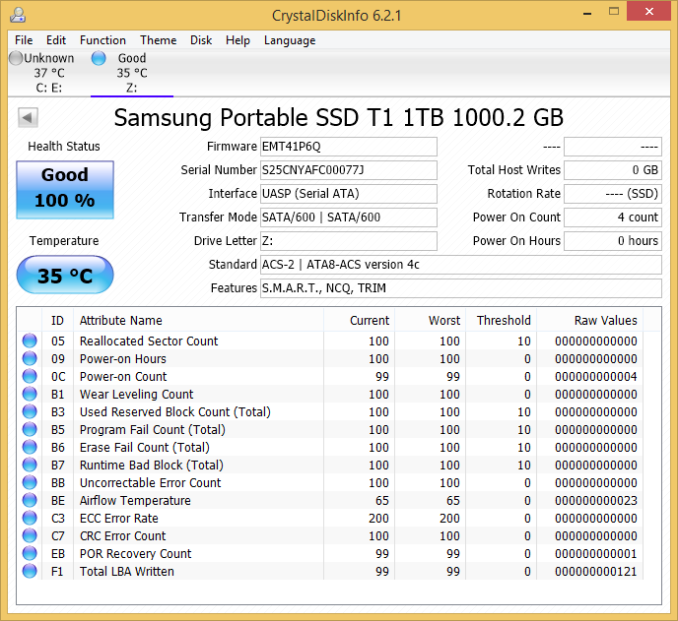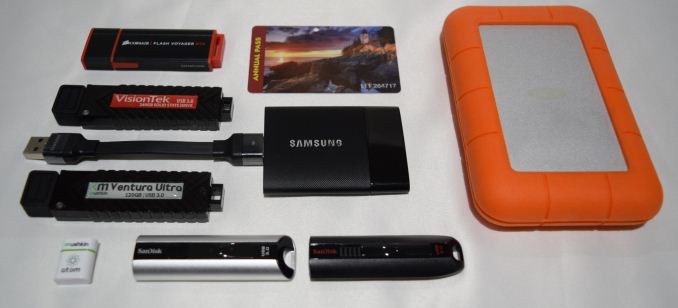Samsung Portable SSD T1 Review
by Ganesh T S on January 20, 2015 10:00 AM EST
Introduction and Testing Methodology
The last few years have seen rapid advancements in flash technology and the rise of USB 3.0 as an ubiquitous high-speed interface on computers. These have led to the appearance of small and affordable direct attached storage units with very high performance for day-to-day data transfer applications. We have already looked at some flash drives with SSD controllers and a USB 3.0 - SATA bridge over the last couple of months. These include the Corsair Flash Voyager GTX 256GB using the Phison S9 controller and the Mushkin Ventura Ultra using the SandForce SF2281 controller respectively.
At CES 2015, Samsung introduced the Portable SSD T1. With the introduction of the T1, Samsung becomes the first tier one manufacturer to enter the external SSD market (if you discount SanDisk's Extreme PRO USB 3.0 flash drives, which, despite being a SSD behind a USB 3.0 - SATA bridge, was never advertised as one). Hardware wise the T1 is based on the 850 EVO, meaning that the T1 uses 32-layer TLC V-NAND and the same full-fledged MEX/MGX SSD controller. CrystalDiskInfo gives us further insight into the unit.
Even though CrystalDiskInfo reports TRIM as a feature, we were unable to get it to work through the bridge configuration. In any case, Samsung also doesn't make any claims about TRIM support. S.M.A.R.T data was not visible to most of the commonly used tools. On the USB 3.0 side, the drive supports UASP (USB-attached SCSI Protocol) that should provide increased performance for sequential transfers. Claimed transfer rates are 450 MBps for sequential accesses and 8K read IOPS / 21K write IOPS. We also have hardware-accelerated AES-256 encryption.
Our review unit was pre-formatted in exFAT. Upon connecting to our testbed, a 128 MB FAT32 partition popped up and provided directions for installing the software / service that allows for the drive to be monitored / utilized with encryption capabilities. After installation, the 128 MB partition disappeared, and the 1 TB volume was made visible. The Samsung SSD program / daemon continues to run in the background and allows for altering the security option (encryption) without reformatting the partition. The gallery below shows the UI of the software running on Windows 8.1 Pro.
Testbed Setup and Testing Methodology
Evaluation of DAS units on Windows is done with the testbed outlined in the table below. For devices with USB 3.0 connections (such as the Samsung Portable SSD T1 that we are considering today), we utilize the USB 3.0 port directly hanging off the PCH.
| AnandTech DAS Testbed Configuration | |
| Motherboard | Asus Z97-PRO Wi-Fi ac ATX |
| CPU | Intel Core i7-4790 |
| Memory | Corsair Vengeance Pro CMY32GX3M4A2133C11 32 GB (4x 8GB) DDR3-2133 @ 11-11-11-27 |
| OS Drive | Seagate 600 Pro 400 GB |
| Optical Drive | Asus BW-16D1HT 16x Blu-ray Write (w/ M-Disc Support) |
| Add-on Card | Asus Thunderbolt EX II |
| Chassis | Corsair Air 540 |
| PSU | Corsair AX760i 760 W |
| OS | Windows 8.1 Pro |
| Thanks to Asus and Corsair for the build components | |
The full details of the reasoning behind choosing the above build components can be found here.
Samsung Portable SSD T1 - Size Comparison (standard credit card size also pictured for a frame of reference)
The list of DAS units used for comparison purposes is provided below.
- Samsung Portable SSD T1 1TB
- Corsair Voyager GTX 256GB
- LaCie Rugged Thunderbolt 500GB
- Mushkin Atom 64GB
- Mushkin Ventura Ultra 120GB
- SanDisk Extreme 64GB
- SanDisk Extreme PRO 128GB
- VisionTek Pocket SSD 240GB


















68 Comments
View All Comments
2kfire - Wednesday, January 21, 2015 - link
Also, I was comparing my laptop experience to yours, in that you were worried your drive was dead, whereas I don't give it a 2nd thought.The HDD bump story was a bonus ;)
Laststop311 - Wednesday, January 21, 2015 - link
This doesn't really make sense as a valid concern. If you need a drive to store data away but never have to access it so you are never connecting it to power for many years you wouldn't buy a pricey fast drive like this since speed is not important at all for data that is just going to be archived and not used. If you need reliable data retention in a pretty economic option just go with the 25GB m discs that use a rock layer to record data. Resistant to extreme light temp and humidity and lasts 1000 years.baii9 - Tuesday, January 20, 2015 - link
be wary that you may need a recent good USB 3.0 chip set with enough pcie lane to take advantage of the drive's adveristed speed. Some usb 3.0 saturated at 200-300MB/sbaii9 - Tuesday, January 20, 2015 - link
Some even stop at somewhere lower than 200.Laststop311 - Wednesday, January 21, 2015 - link
As long as you are using a native usb 3.0 lane directly off the chipset and not one off a controller you will have the full speed.baii9 - Wednesday, January 21, 2015 - link
ivy hasewell and broadwell only then, or sb on a ivy board+ amd~That's not alot of machine.
xilience - Tuesday, January 20, 2015 - link
Would it be possible to include a reference external HDD in these charts (and a reference HDD in all SSD charts) to compare to what 95% of people currently have? While the Samsung T1 seems to be twice the speed of, say, the Corsair GTX, it'd be nice to see just how much faster those options are versus a standard external HDD.akdj - Tuesday, January 20, 2015 - link
Black Magic, CrystalMark... & plenty of 'free/shareware' is easily located, downloaded and extremely light weight. You're welcome to run your own tests using the same benches the site uses. Some, like 64bit GeekBench support require a couple bucks but you don't 'need' it to measure the performance of yiur current rig. Plenty of similar or identical CPU and GPU matches to yours are available to compare on the different sites for benchmarksThese types of speeds on a 3.5" HDD would require drives in RAID, proper enclosure, 7200 RPM drives with 'power' and more than just a pair;). Even then I'm not sure you'd be able to achieve these speed at twice, even three times the cost...in dollars. In capacity, the winner is still obvious but the prices have dropped significantly in the past 24-36 months. And many vendors are switching. This size, a TB, with bus power is an absolute beast. And at twice the capacity of my Lacie Rugged TBolt 500GB SSD, it's a bargain.
Laststop311 - Wednesday, January 21, 2015 - link
There are tons of benchmarks for external hard drives easily found. You are lucky to even hit 100MB/sec reads off a regular HDD and it's usually below that for the mass majority of externals as they are usually 5400 rpm low power models.jasaero - Tuesday, January 20, 2015 - link
Is anyone making a more portable mSATA USB 3.0 enclosure? Or why not a 4 slot mSATA battery powered pocket NAS!! So many products one could do with these tiny flash memory formats and nobody is doing them.